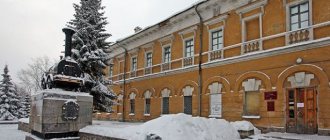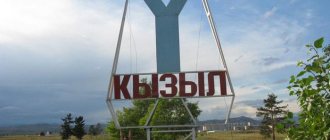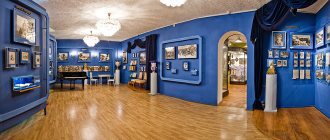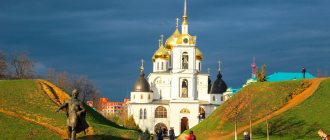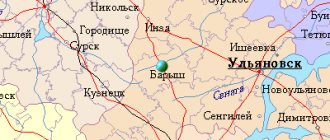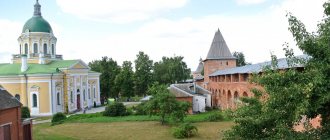On the banks of the Volga stands the city of Kimry, whose history began in the 16th century. For a long time it was considered the "shoe's edge." Cheap cattle were transported along the river past the town, which were bought for making shoes. During the reign of Peter I, the best shoemakers worked here. They made shoes for the Russian army. Thanks to the shoemaking industry, the city became rich, and the population began to lead a free lifestyle. It was at that moment that the phrase “drunk as a cobbler” appeared.
In 1915-1917 Kimry became a city. It had its own railway and a large shoe factory.
The name “Kimry” is an unusual word for Russian ears. The Chimera are ancient Celtic tribes. But they lived in the mountains of Wales and had never been to the Volga region. At the same time, there is a version that the Merya tribe lived on the site of the city of Kimry. These are Finno-Ugric tribes that came from the Trans-Urals and settled between the Oka and Volga rivers. And in the Celtic language, Merya and Cymry are the same word.
There are many interesting places around the city in the guide to the Tver region.
For ease of route planning, we have marked all the mentioned attractions on the city map:
Historical sites and museums
Kimry Local Lore Museum
Address: st. Kirova, 13/18 Phone: +7 (48236) 31267 Website: https://muzeykimry.ru Opening hours: 10:00 – 18:00 Wed-Sat, 10:00 – 17.00 Sun, Mon, Tue – closed Cost: students and pensioners – 50 rubles, adults – 100 rubles.
The museum has a permanent exhibition, which presents objects of everyday life and life of people since ancient times. The originals of the 16th-18th centuries are of particular value.
Visitors can see the restored interiors of a peasant's room, an Art Nouveau living room and interiors from the 30s to the 70s of the 20th century.
The museum has been running the multimedia exhibition “Capital of the Shoe Kingdom” since 2022. Visitors will interactively see the appearance of the streets, houses and life of the Kimryans of the 19th-20th centuries.
Kimry Drama Theater
Address: Teatralnaya Square, 2 Phone: +7 (48236) 31760 Website: teatr-kimry.ru Opening hours: 09:00 – 18:00 Mon-Fri Ticket prices: ground floor – 300 rubles, balcony – 370 rubles
The theater began its work in the summer of 1942. Throughout the war, the theater hosted 2-3 performances a day. In the morning, the theater troupe performed in hospitals, and in the evening ordinary residents came.
The theater actively developed when it was directed by A. M. Giatsintov. The troupe toured to Moscow and St. Petersburg, famous actors played in the performances, and after the war the theater received a certificate from I.V. Stalin.
But in the 70s, the theater was closed for reconstruction and opened on October 26, 1991.
Today, not only plays are staged in the theater. Before the performance, the audience will enjoy a performance by musician V.V. Borisov. New Year's performances for children are held annually, and the repertoire is supplemented by premieres.
District House of Crafts and Folklore
Address: st. Kirova, 19 Phone: +7 (48236) 31309 Website: https://kimrymaster.ru Opening hours: 09:00-17:00 Mon-Fri, 10.00-16.00 Sat, Sun Cost: 50 rubles
The craft school is located in an old building. Here in the 19th century lived the wealthy family of the peasant woman Shkvarina. She and her sons were engaged in trading and ran a farm. Since then, the house has remained unchanged and has not required major reconstruction.
The school began operating in 1995-97. It immediately began offering classes in hand embroidery, wood carving and leather working. All classes were aimed at students learning the folk crafts of the region.
The school has a folk costume laboratory. Traditional outfits that are used for performances by folk groups and performers are recreated here. At the museum, you can pre-book a group excursion, which will tell you the history of folk costume and conduct a master class on making a doll.
Kimry Local Lore Museum
The Kimry Museum of Local Lore, a branch of the Tver State United Museum, was founded in 1918. The area of the modern exhibition is 752 square meters. m, there is an exhibition hall.
Museum address: 171506, Tver region, Kimry, st. Kirova, 13/8.
Phone: +7 (48236) 3-12-67 (general), 3-27-43 (director).
Opening hours: Wed, Thu, Fri, Sat - from 11:00 to 18:00; Sun - from 10:00 to 17:00; Mon, Tue – closed.
Official website of the Kimry Museum of Local Lore: muzeykimry.ru
Social networks: vk.com/Museum.Kimry
Below you can see photographs
Museum halls:
- Hall 1. Archeology. Ancient world.
- Hall 2. First mentions of Kimry.
- Hall 3. Development of the village of Kimry.
- Hall 4. Kimry XIX - early XX centuries. Golden age of the Kimryaks.
- Hall 5. Revolution, civil war, 1930s.
- Hall 6. The Great Patriotic War.
- Hall 7. The city of Kimry in the 70-80s. XX century. Soviet time.
- Hall 8. Memorial Hall A.N. Tupolev
- Hall 9. Nature
- Capital of the Shoe Kingdom
The permanent exhibition introduces visitors to the history of the region from ancient times to the present day.
The Kimry district is one of the most archaeologically studied in the Tver region thanks to pre-war research, reconnaissance work of Tver State University and stationary research of the Institute of Archeology of the Academy of Sciences in recent decades. It was here that modern research methods were developed.
In the Kimry Volga region, many unique archaeological monuments : settlements of the Mesolithic era, settlements (early Iron Age, burial mounds and settlements of Old Russian times. The exhibition presents maps and photographs of archaeological monuments, scientific literature devoted to them, research reports, models of excavations of a production site of a Stone Age site (VIII-VI millennium BC), burials of the Fatyanovo culture of the Bronze Age (1st half of the 2nd millennium BC), a mound of Old Russian times (XI-XII centuries AD).
The archaeological themes of the exhibition show the close relationship between the natural environment and human society, the degree of dependence of the material and spiritual culture of man of that time on his habitat. Materials on the topics “Mesolithic” and “Neolithic” are presented against the background of natural history dioramas. This is the first experience in the association, which makes the exhibition stand out from others. Thanks to the many years of collecting by local historian O. Barabanov, the exhibition includes objects of mass material culture of the 14th-18th centuries.
The historical sections open with unique documents, the main one of which is Ivan the Terrible’s letter to the Kirillo-Belozersky Monastery (1546), where the village of Kimry was first mentioned. Authentic objects of the 16th-17th centuries attract attention : an icon embroidered with gold, a treasure of silver coins, weapons, peasant utensils, forged doors. Visitors are introduced to the first image of Kimry - the engraving by A. Grekov “The Village of Kimry from the Meadow Side of the Volga” (1772).
The exhibition is rich in interiors. portraits of village residents from the mid-19th century and noble furniture will not leave visitors indifferent .
Kimry is a rich trading village, so it was a palace possession or passed into the hands of people close to the court. Thus, Fyodor Saltykov received Kimry in 1688 in connection with the marriage of the daughter of Praskovya Fedorovna, who became the wife of Tsar Ivan V. In 1762, Kimry was granted to Empress Elizabeth’s cousin Anna Karlovna Skavronskaya and was the property of the Skavronsky family until 1846, when the Kimryaks, having occupied in the treasury, 495 thousand rubles in banknotes with installments for 37 years at 6% per annum, were bought out from Countess Yu. P. Samoilova. The deed of sale for the village of Kimry and a map of the estate of Countess Yu. P. Samoilova are presented in the exhibition along with interesting documents of serfdom.
The panorama “The Glorious Village of Kimry” was made from old photographs .
Kimry is known as the center of the shoe industry. shoe collection is one of the richest in the country. Here are skillful samples made by artisan shoemakers at various times from the 16th to the 20th centuries. Each sample is a work of art. Shoemaking is revealed in the unique creations of the sculptor I. M. Abalyaev. His works “Okhodniki”, “Meeting with the owner”, “Taking shoes to the market”, “Seeing off to study” and others give a unique originality to the exhibition.
Antique furniture, dishes, clothing and photographs from the early 20th century introduce the life of wealthy Kimryak people. The documents of the volost government reveal the nature of the local social structure.
Among the exhibits is a birth register with a birth record in the village of Kimry on December 24, 1901 (but in a new style) by the writers A. A. Fadeev .
The history of the Great October Socialist Revolution and the Civil War is revealed in authentic documents and photographs.
Of particular interest are the photographs of Leonid Vladimirovich Shokin from the 1920s to the 50s , the organizer of the photographic society in Kimry, a participant in many international exhibitions, and a photojournalist for the Soyuzkinochronika agency.
Numerous materials tell about the Great Patriotic War of 1941-1945. The central showcase is dedicated to home front workers. Here are the products of local enterprises : shoes for soldiers and officers, boots for German prisoners of war, canvas shoes for civilians, three-finger gloves and windings, underwear for soldiers and much more.
12.5 thousand Kimryaks died on the battlefields, ten were awarded the title of Hero of the Soviet Union. The photographs show war participants who marched from Moscow to Berlin.
In the section on restoration and development of the national economy, a rare artistic technique of photo collage , which reflects the 1950-60s. Displays dedicated to healthcare, education, and culture will attract the attention of visitors. in embroidery and lace making is amazing .
Of interest is the stand about the drama theater , led in those years by Alexander Mikhailovich Giatsintov. A whole galaxy of magnificent actors played on the Kimra stage: V. A. Vishnevskaya, M. M. Charukhina, B. S. Grachev.
Kimry district is the birthplace of the outstanding aircraft designer A. N. Tupolev . The museum contains models of his planes, furniture from Andrei Nikolaevich’s office, and personal belongings.
The materials about the modern city, the development of industry and agriculture are unique.
A large part of the exhibition introduces the nature of the region , with the powerful impact of human activity on it. Photo montages, dioramas with stuffed animals, and herbarium specimens are interesting. Of course, no one will pass by the beauty of our forests - the moose. It seems that his eyes look reproachfully at inanimate nature in a colorful diorama, where there is no place for our smaller brothers. But each of us must do everything so that the lily of the valley and the spruce, the starling and the forest giant can always find their place next to a person. And only this way, together, will we be alive and happy on this Earth.
Photos of the exhibitions of the Kimry Museum of Local Lore
Below are photographs of some of the museum's exhibits.
Parks and monuments, streets
Monument to the shoemaker
Address: st. Kirova, 18
The monument to the shoemaker was opened in September 2014 on the initiative of local residents. It was Kimry that was famous for its shoemakers since the 17th century.
To create the monument, a charitable foundation was opened under the leadership of A. Andreev and V. Sukovatitsyn. Over the course of 2.5 years, the fund collected the necessary funds from entrepreneurs, enterprises and donations from individuals.
Samvel Sardanyan, a member of the Union of Artists of Russia, worked on the creation of the monument.
It is believed that this is the only monument to a shoemaker in Russia.
Monument to the TU-124 aircraft
Address: street 50 let VLKSM
Kimry is the birthplace of A.N. Tupolev. He was an outstanding engineer in the field of aircraft construction. Thanks to him, more than 100 types of civil and military aircraft were developed. His inventions are a model of domestic aviation for many foreign engineering bureaus.
The TU-124 aircraft stands on the opposite bank of the Volga, not far from the aircraft plant. In 1984, it was donated by the design bureau of A. N. Tupolev to residents of the city of Kimry. The plane flew to the city on its own, and from the Borki airfield it was towed to the bridge over the Volga.
In the first years it was a popular monument among local residents. They took pictures here and held meetings. But in the 90s, the plane was damaged by vandals. The administration is currently working to restore the appearance of the aircraft.
Fadeev embankment
Fadeev Street is the oldest street in the city of Kimry. Before the revolution it was called Embankment. Since the 60s, it began to be called Fadeev Embankment in honor of the author of the book “Young Guard”.
It is better to start a walk along the embankment from the first building, which housed the Chaika Hotel. The house was built in the mid-19th century and belonged to the Chernigovsky family. They founded a hotel in their house and developed the fire service in the city. During Soviet times, the hotel became state-owned.
Previously, there was a wooden house behind the hotel. The merchant M.I. Ponomarev, the doctor I.I. Ponomarev and their sister O.I. Ponomareva lived in it. During the years of his life, the doctor Ivan Ivanovich Ponomarev cured many residents of the city of Kimry. He conducted his medical practice only at home and did not leave it. But the family faced a sad ending. None of them had children, so with the death of their brothers and sister, the clan ceased to exist. The house was dismantled in the late 70s of the last century.
House No. 4 belonged to wealthy merchants Shkvarins. The brothers owned a steamship with barges and traded on it along the Volga. The house had a platform from which the brothers could watch musicians’ concerts on the embankment. But with the advent of Soviet power, the brothers’ trade stopped, a hospital was set up in the house, and then a police detachment.
In house No. 6, the merchant Rybkin lived on the first floor, and the second floor was rented by an agent of a shipping company. The famous writer Saltykov-Shchedrin visited the hosts. But there is no reliable information about his residence in the city of Kimry.
House 39 has been preserved, which is now on the corner with Lenin Street. It belonged to tanner V. M. Kryukov. Under Soviet rule, communal apartments were built in the house.
In house No. 11, the Falchevsky family lived on the first floor, and actress A. M. Zaitseva lived on the second floor.
Historical buildings after crossing the embankment with Radishchev Street have not been preserved.
Churches and Temples
Temple of the Ascension
Address: Kalyaevsky lane, 2 Phone: +7 (48236) 31753 Website: vozneseniekimry.ru Opening hours: 09:00-14:00 Mon-Thu, 09:00-19:00 Fri-Sun, 14:00 - 16:00 break
The bell tower of the temple is visible from almost anywhere in the city. It was built in 1813 to replace two burnt wooden churches. Since then, it has undergone alterations, but has retained its general appearance.
The temple was erected at the expense of parishioners and merchants the Bashilovs. Thanks to the merchants, the refectory in the temple was later expanded, decorations were added, an iconostasis was installed, and the bell tower was reconstructed. After their death, the brothers bequeathed funds for the maintenance of the temple.
For a long time, a document from the 17th century was kept in the temple. It was signed by Tsars Ivan and Peter and issued to the boyar Saltykov. But at the beginning of this century the letter was transferred to the Tver museums.
In addition to the diploma, the church kept a silver cross of Countess Samoilova, an icon of Dmitry of Solon, an image of the Savior and the Sign of the Mother of God.
During the Soviet government, the temple was seized and used as a warehouse for Kimrotorg. The status of the temple was returned only in the early 90s.
Transfiguration Cathedral
Address: st. Uritskogo, 65 Phone: +7 (48236) 31970 Website: kimry-sobor.ru Opening hours: 08:00-12:00 Mon-Fri, 07:30-19:00 Sat-Sun
Construction of the temple began in 1902 and was completed in 1911. During this period, they did not have time to build the stone bell tower, and after the revolution, the Soviet authorities forbade its completion. In 1927, a document was signed on the closure of the temple. But on the first attempt, the authorities failed to describe the property. On the day of closure, parishioners surrounded the church and did not let officials in. They turned to the police for help. After the arrest of the instigators, the temple was described and closed.
At first, the building was used to house artisans, but then they began to store grain there.
During the Great Patriotic War, the church made a tangible contribution to the victory, which allowed parishioners to visit it after the victory over the Nazis.
Attractions in the surrounding area
Zoocircus Kolkunovo
Address: Kimry district, Pleshkovo village Telephone: +7 (495) 7369486; +7 (916) 7369449 Website: kolkunovo.ru Opening hours: around the clock How to get there: from the city of Kimry, move 17 km towards the village of Pleshkovo. The complex is located at the exit of the village.
On the territory of the Kolkunovo complex there is a petting zoo with horses, ponies and other animals.
Adults can enjoy water sports, visit the sauna, and go fishing.
There are several houses available for accommodation with a capacity ranging from 2 people to 10.
UFO Park
Address: Pleshkovo village, Leninsky pr., 72/2 Telephone: +7 (495) 7369486 hours: 24 hours Cost: 550 rubles – complex ticket; 250 rubles – for children over 3 years old How to get there: from the city of Kimry, move 13 km towards the village of Pleshkovo
A large amusement park opened in the suburbs of Kimry in 2014. The territory has a variety of children's attractions, playgrounds, a rope park for adults and children, a swimming pool, and a zoo.
The zoo features domestic and exotic animals. The park occupies a large area, so many animals live in the forest in comfortable conditions.
The park is located on the shore of a pond where you can go fishing or swim on a catamaran.
You can relax after a walk in small cafes, which are evenly distributed throughout the complex.
Museum of reptiles
Address: Volzhsky village, st. Vostochnaya, 4A Phone: +7 (48236) 79348 Website: muzey.gadovo.ru Opening hours: 08:00-16:00 Tue-Fri, 11:00-16:00 Sat, Sun, Mon - closed How to get there : drive 30 km from the city of Kimry along the Kimry – Bely Gorodok highway
Volzhsky was formerly called Gadovo. According to one legend, this village is the birthplace of the fairy tale hero Zmey Gorynych. According to another version, there were always a large number of snakes in this village. But due to the dissonant name, in the 60s Gadovo was renamed Volzhsky.
Now the museum exhibits snakes made from a variety of materials. It is best to visit it with children. Various events are organized for them, they are told about the history of the region, about snakes and how to behave.
There is a Russian-style cafe in the museum building.
Church of Our Lady of Jerusalem
Address: Bely Gorodok village Phone: +7 (48236) 3-92-98 Website: hram-belogorodok.ru How to get there: follow the Kimry – Bely Gorodok highway 20 km
The history of the church is closely connected with the icon of the Mother of God of Jerusalem. According to legend, the miraculous icon was painted by the Evangelist Luke. The icon was kept near the right choir.
After the revolution, the temple was closed. In the 90s, a religious community was formed, which achieved the opening of the temple and the restoration of the church.
If you have not yet chosen where you will live and want to save money when booking, we recommend using the RoomGuru service. Firstly, it contains hotels, apartments and guest houses from many different booking systems, so you won’t miss out on a worthwhile option. Secondly, you can immediately compare prices for one place in different services and book where it is cheaper (this is not always Booking!).
Kimry
The Dutch say: “He who sits within four walls experiences the most difficult part of his journey.” Life in search of joyful experiences is much easier than you think. Here, one of my last joyful events is a trip to the Kimry fairy tale. So, let's open the door...
Liked!
3
3
Author: PremaInna
The fair meets the traveler at the entrance to the exhibition!
Kimry Local Lore Museum. The largest museum of shoes of the 18th - 20th centuries in Russia, the real “shoe kingdom” welcomes us with a fun fair in patchwork style!
Liked!
4
4
Author: PremaInna
And this is Kimry! Do you recognize?
Do you know what birds are found in the witchcraft forests of the Tver region? They can be found here. And different animals...
Liked!
3
3
Author: PremaInna2
Guess who it is...
This strange place, where the history and life of the Kimry district is revealed in all its colors, is located in the very center of the city of Kimry, on the very banks of the Mother Volga.
yandex.ru/maps/-/CBeGvXbbSD
The Kimry Museum of Local Lore demonstrates the life of the Tver region and the glorious city of Kimry, its inhabitants since the time of Tsar Gorokh. The exhibition halls are decorated skillfully and lively, and the staff here are friendly and helpful.
Liked!
0
0
Author: PremaInna
Forest animals of the Tver region
In the hall dedicated to archeology and the ancient world, I unexpectedly learned that mammoths lived in these places after the onset of the glacier 10 thousand years ago. Like these ones!
Liked!
3
3
Author: PremaInna
And these colossi once walked along the snow-covered steppes of the Kimry region
Kimry local historian A. Sukhanov, who made a colossal contribution to the process of studying the history of this region, believed that in ancient years in Rostov-Suzdal Rus' the place of Kimry was already called a town, as it was mentioned in the historical chronicles of 1096.
Liked!
1
1
Author: PremaInna
The archaeological exhibitions are impressive!
Although the important documents that have reached us indicate the settlement of Kimry from the middle of the 16th century, I understand that the territory of the current city and its surroundings were inhabited much earlier. And this is evidenced by the skeletons of small people found in the vicinity of Bely Gorod. This is exactly what the human beings who survived on Earth after the onset of the glaciers were like.
Liked!
1
1
Author: PremaInna
The mounds of the village of Pleshkovo, Kimry district, speak of the antiquity of these places...
The archaeological halls of the museum display the remains of ancient people excavated in mound groups near the village of Pleshkovo, Kimry district.
Liked!
0
0
Author: PremaInna
Skeletons found in graves near ancient settlements
Shoe production has developed on a remarkable scale in Kimry. Although people were previously engaged in many trades on these banks of the Volga, the need of fishermen, barge haulers, and barge builders to protect their feet from dampness did its job.
Liked!
1
1
Author: PremaInna
It was with these boots that the life of the “shoe kingdom-state” began for the Volga residents
By the middle of the 17th century, the shoe craft was gaining momentum, thanks to the needs of not only local Volga residents, but also the capital’s residents of the harsh northern climate. Oddly enough, it was in Moscow that good shoemakers were hard to find during the day, but in Kimry there was an abundance of them. And the Kimryaks played on this. They made the capital's nobility their first buyers. Kimry craftsmen began to gain strength in the newly created craft artels of the capital city, and Kitay-Gorod was not ignored. This is confirmed by Moscow letters from 1666-1676: “At the Nikitsky Gate, near the widow of the priest Matryona, the peasants of the palace village of Kimry lived: Boriska Ivanov, Ganka Emelyanov... and from Kimry, the townsman Stepka Fedorov.”
Liked!
4
4
Author: PremaInna
The glorious village of Kimry
In another document we read: “Yes, under the church in a tent, the peasants of the Kashinsky district of the courtyard volost of Kimry live, Ivanko Frolov, ... Styopka Vasiliev has been making boots for ten years.”
Liked!
0
0
Author: PremaInna
The work of the Kimryak shoemakers brought glory and prosperity to these places
By the end of the 19th century, more and more peasants were leaving their native villages and mastering the difficult but noble business of shoemaking. By that time, more than half of the inhabitants of Kimry were engaged in the production of shoes. In terms of the number of jobs employed and the cost of goods, shoemaking has become a leader among handicraft industries in the Tver province.
The leather industry initially took on a very crumbly, pointy appearance. Large factories did not appear immediately. Only the plant near the village of Abramovo could boast a huge steam boiler and employees of as many as 133 people.
Liked!
0
0
Author: PremaInna
THEM. Abalyaev reflected the real life of shoemakers in his tiny sculptures
In the fourth hall of the museum, I marveled at the original reproduction of the development of Kimry at the beginning of the 20th century.
The shoemaking art of a unique village is revealed here in the unique works of sculptor I.M. Abalyaeva. His works reflect the life of that era and add a picturesque flavor to the museum’s exhibition. THEM. Abalyaev was born in 1901 in the village of Nutroma (now the territory of the Kimry district of the Tver region) in the family of an ordinary shoemaker. From an early age he was familiar with the painfully hard life of a shoemaker, simple life, joys and sorrows. And the sculptor reflected all this in tiny wooden figures so convincingly!
Liked!
5
5
Author: PremaInna
The interiors of the residents of Kimry are impressive
The museum presents interiors from different eras and representatives of different segments of the population, mainly from the 2nd half of the 19th century. And they say that the people lived here richly and joyfully.
Liked!
3
3
Author: PremaInna
Color and craftsmanship of the Kimri kingdom
Shoes, dishes, clothes and photographs from the early twentieth century give us an idea of the life of the Kimryaks.
Liked!
0
0
Author: PremaInna
Antique banknotes in exchange for the best Russian shoes of past centuries
Here you can even see very impressive banknotes, for which you could buy high-quality Kimry shoes, which were already famous throughout Russia at that time.
Liked!
1
1
Author: PremaInna
This is a living shoemaker, frozen in the memory of his descendants
The exhibition also includes actually recreated paintings of shoemakers at work!
Well, the memorial hall of the outstanding Soviet aircraft designer Andrei Nikolaevich Tupolev, who was born in the Kimry district, is beyond praise... But it’s better to see it with your own eyes.
Come, friends, to the wonderful local history museum of the city of Kimry, open new pages of Russian history with me!
Chip flights
Find a hotel

